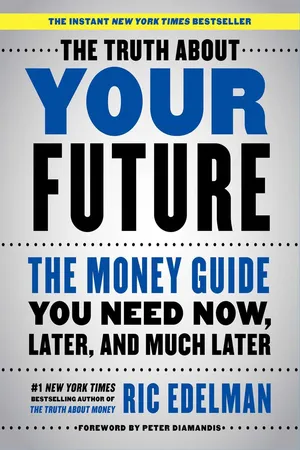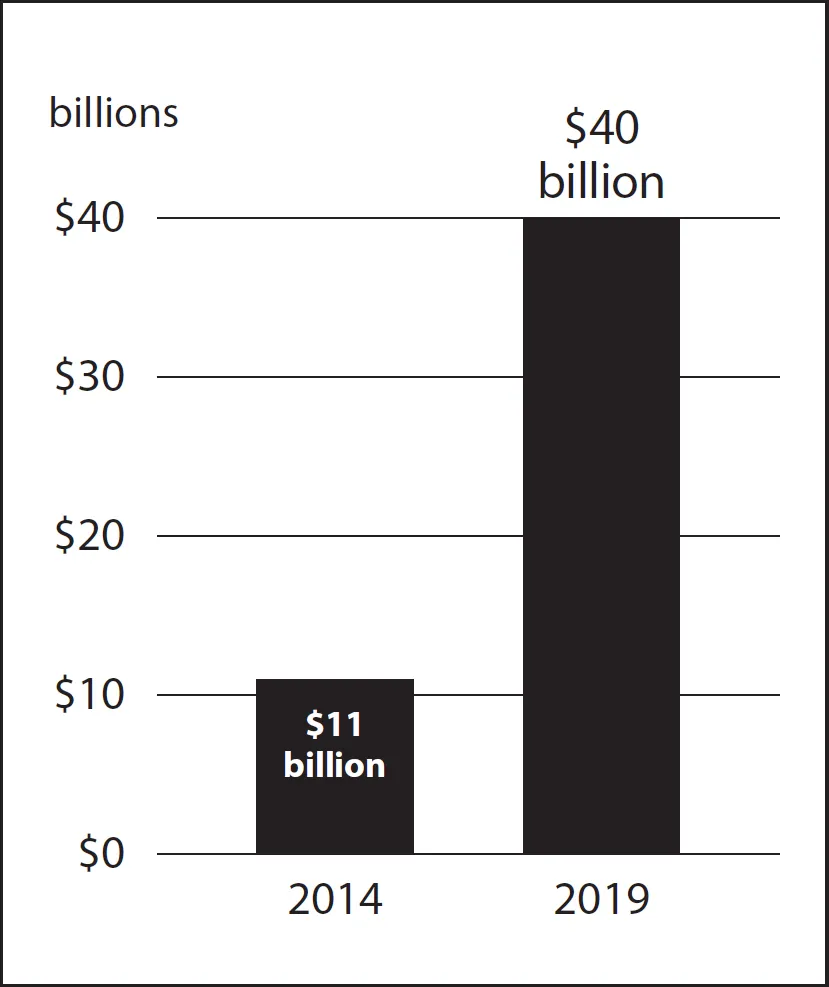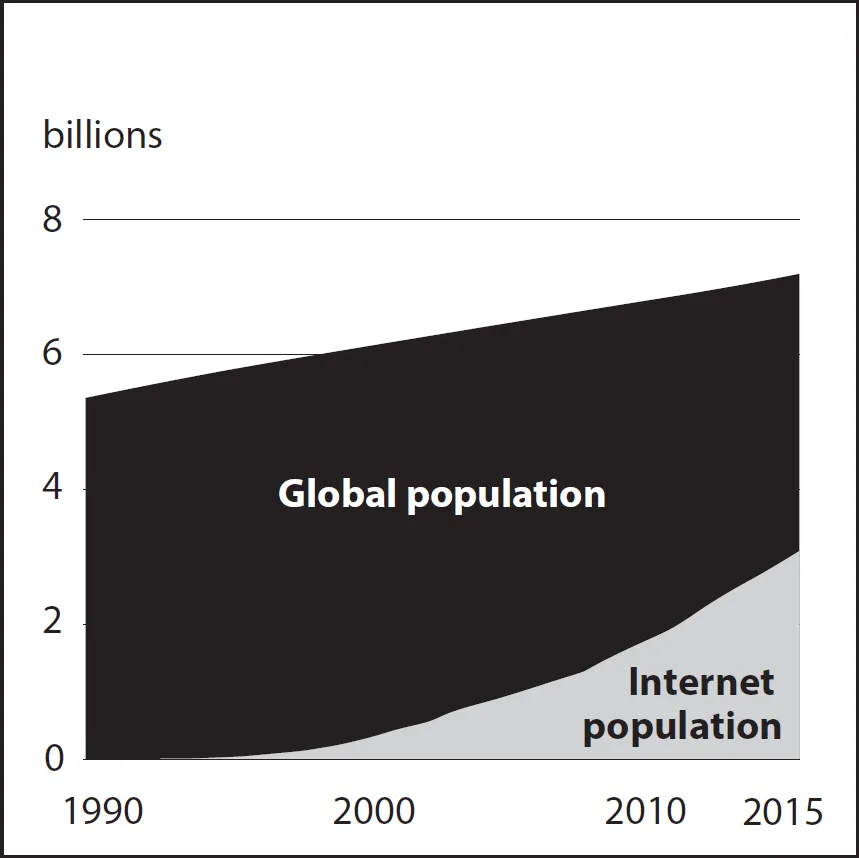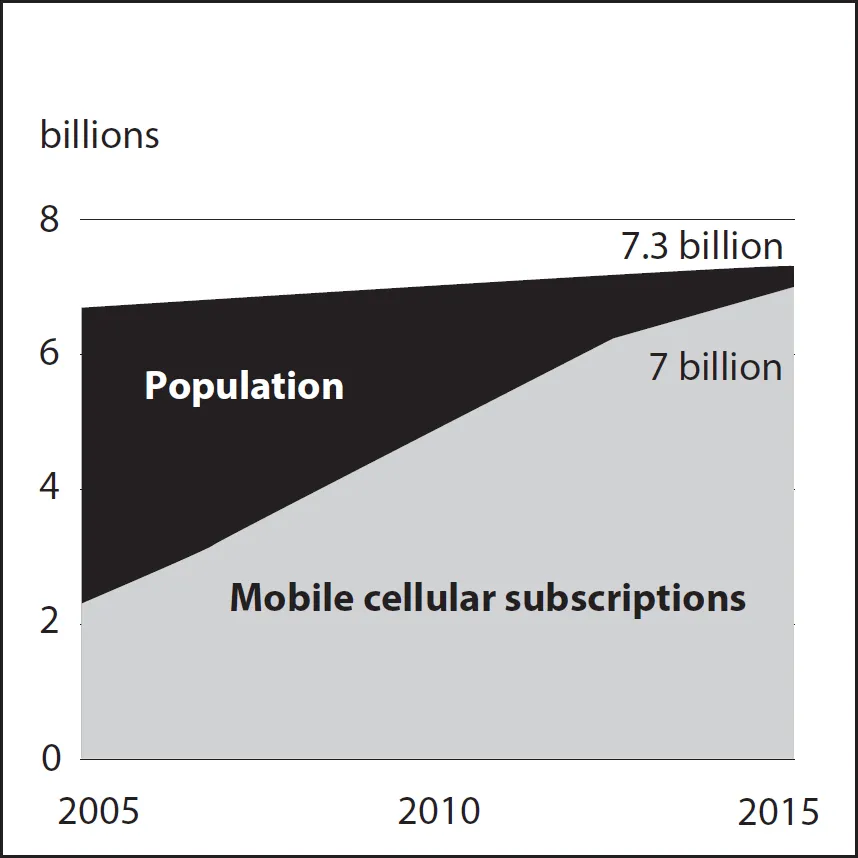![]()
PART ONE
A Tour of Exponential Technologies
![]()
Chapter One: Connecting with Each Other
I couldn’t wait until I got my driver’s license! Having a car (or, rather, borrowing my mom’s) meant I was able to get to the mall, to my friend Peter’s house, to anywhere my friends would be hanging out. Having a car meant being connected, and being connected was vital for a teenager.
It still is. But it no longer takes an automobile to do it. Today we connect online, and physical proximity is no longer relevant. It’s no surprise, therefore, that today’s youths are less dependent on automobiles. According to the University of Michigan Transportation Research Institute, nearly half of 18- to 24-year-olds say they would choose having Internet access over owning a car.
PREFERENCE OF 18-24 YEAR-OLDS
Connectivity turns even the mundane into a marvel. Consider pizza, one of the world’s most popular foods. It’s also one of its oldest and to a large extent is still made the way it’s been made for centuries. But the way it’s sold is changing rapidly. Domino’s, for example, lets you order a pizza via voice command while driving a Ford Fiesta. Using GPS technology, the store knows where you are and can calculate how long it will take you to get home—so the pizza arrives when you do.
Not to be outdone, Pizza Hut lets gamers order pizzas while playing with an Xbox—no need to interrupt the game merely to manage your munchies. Both companies say half their orders arrive digitally, and both say their IT departments are the fastest-growing divisions in their businesses.
Thanks to online connectivity:
• Facebook was able to become huge. That’s where people are for two minutes out of every seven that they’re online.
• 30 billion messages were sent using WhatsApp in 2015.
• YouTube’s 1 billion users view 4 billion videos every day and upload 300 hours of video every minute.
• Google generates more revenue than all newspapers and magazines combined. YouTube, iTunes and Netflix each generates more revenue than the AMC cable network.
© 2016 KFS King Features Syndicate, Inc.
And much of this connectivity is being done via mobile devices. Nine in 10 Americans have a mobile phone, and there are now more mobile devices connected to the Internet than desktop computers. In fact, according to the Mobile Marketing Association, there are now more mobile phones on the planet than there are toothbrushes—and, unlike toothbrushes, more than 90% of smartphone users keep their phones within arm’s reach 24/7.
Lots of people are already using their phones to make purchases—and I don’t just mean by ordering products using Amazon’s mobile app. At Cheesecake Factory and other restaurants, your order appears on an app, and you can pay the bill whenever you want—even splitting it with others dining with you—without having to wait for the server to bring the check. The Sweetgreen restaurant chain won’t even let you pay with cash; you must use an electronic form of payment. Android Pay is accepted at more than 1 million stores, Samsung Pay can be used at swipe-only terminals, and Apple Pay can be used with credit cards from 1,300 card issuers. Chase, Capital One, and Walmart are among those launching ways to make it easier for you to pay your bills. In 2015, 45% of all online purchases made in the United States were done via a mobile device, according to Demandware.
Soon, though, it won’t be our telephones that connect us to the Internet—it’ll be our clothing. Researchers are developing clothes that kill bacteria, trap toxic gases, conduct electricity, block ultraviolet rays, measure our heart rate, analyze our sweat, monitor brain signals, heat or cool our skin—and let us talk to each other.
Levi’s has partnered with Google to create conductive fabrics, while Ralph Lauren sells a shirt that detects your breathing, heart rate, stress level and calorie burn—sending the data to a smartphone app that creates a custom workout program for you. The shirt, which features an accelerometer and gyroscope to capture movement and direction, sells for $295. (Expect the price to come down.)
NEARLY 3 BILLION PEOPLE ARE ONLINE
AND THEY HAVE NEARLY 7 BILLION DEVICES
Sales of connected wearables were $11 billion in 2014 and are projected to be $40 billion by 2019, according to IHS Markit.
It’s one thing to connect people to the Internet; it’s quite another to connect the things people use. And that’s a problem, because the Internet is running out of capacity. Today’s platform can handle only 4.9 billion devices. Considering that 3 billion people are already connected to the Internet (many with more than one device—the number of mobile devices is about to outpace the number of people on the planet), it’s obvious that we’re running out of room.
That’s why a new platform is being launched in 2020. It will have the capacity to handle 78 octillion devices—that’s 78 billion billion billion devices. In other words, every grain of sand on earth could have 1 trillion IP addresses.
The Internet of Things
That will move us to the next phase of connectivity, to what is being called IoT—the Internet of Things. Everything that operates with electricity will be connected to the Internet, as will a great many things that don’t use electricity, such as food.
Drew Dernavich/The New Yorker Collection/The Cartoon Bank
This is already under way. You can install thermostats that let you alter room temperatures without being in your house; the devices can also detect when people enter the room and adjust the temperature accordingly. Samsonite, Trunkster, Hontus, LugLoc and LEV Technology offer luggage that features Wi-Fi hot spots, USB chargers, digital locks, built-in scales, Bluetooth speakers and cellular-enabled tracking systems so you always know where your bag is. Refrigerators can tell you when the milk has gone sour or that the carton is low. (Soon the refrigerator will place the order for you, and the milk will be delivered to your home without your taking any action—probably by a drone.)
In 2015, only 4 billion devices were connected to the Internet. By 2020, there will be 50 billion, and by 2030 there will be 1 trillion. We’re just 1% of the way there.
NUMBER OF CONNECTED DEVICES
Virtual Reality and Augmented Reality
As exciting as mobile connectivity is, that’s nothing compared to two other emerging exponential technologies: virtual reality and augmented reality.
VR goggles cover your eyes, making you feel as though you’re immersed in a different universe. You can explore maps of the brain’s neurons, check out your favorite retailer’s latest products or roam forests where you can fight dragons with virtual weapons.
By 2020, according to Fortune magazine, virtual reality devices will let car buyers test-drive vehicles, doctors practice surgical procedures, military procurement officers evaluate defense system capabilities, cruise ships let you see what a vacation experience would be, hotels let travelers visit their properties without actually having to go there and architects take you on tours of buildings before they are constructed.
Those who’ve used VR complain that the goggles are bulky. And when you’re using them, you can see only the alternative reality being displayed; you’re unaware of your actual surroundings. That limits the devices’ practicality. These problems are solved by an even more fascinating technology, called augmented reality.
Ken Krimstein/The New Yorker Collection/The Cartoon Bank
AR doesn’t require you to wear headgear; instead you just aim your smartphone or tablet’s camera (and, in the future, your eyewear) toward an object. Instantly a display pops up, providing you with details about whatever you’re looking at.
While watching a ball game, point your phone’s camera at anyone on the field—and it will reveal the player’s name, key performance statistics and video highlights. Tourists will be able to point their phone at a famous landmark and instantly receive information about the site. Surgeons will be able to use the devices to see arteries invisible to the naked eye.
In 2017, 2.5 billion AR apps will be downloaded onto smartphones worldwide. The most famous so far was launched in 2016: the game Pokémon Go. You simply look at the image shown by your phone’s camera; while doing so, Pokémon characters appear on your screen as though they really exist. The goal of the game is to capture as many characters as possible. But first you have to find them—and that means walking around, not just in your house but throughout your neighborhood, even traveling to other cities. Parents who lament that their video game–playing kids get no exercise are relieved that this game requires outdoor physical activity.
A Case Study in Exponential Technologies
Because Pokémon Go was the first widely available consumer AR application, it’s worth taking a closer look at it. There are 7 billion people in the world, and few gave any thought to augmented reality until July 6, 2016, when the game was released. Within weeks, more than 75 million people worldwide were playing it—making it the most downloaded app in history.
Financially speaking, the immediate beneficiaries were Nintendo, Niantic (the game’s creator) and Apple (which gets 30% of the revenue collected by the game through its App Store). The investment banking firm Needham & Compan...








